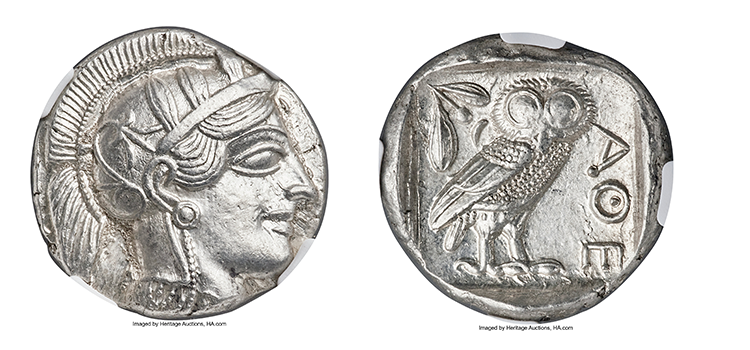Athenian Tetradrachm
During the second half of the fifth century, the abundant silver mines of nearby Laurium allowed Athens to produce millions of tetradrachms. The silver coins helped fund the Golden Age of Athens, during which the military, politics, and culture of the ancient Greek civilization flourished.

Golden Age of Athens
In 479 B.C., the Greek city-states finally halted the Persian invasion at the Battle of Plataea and united to form the Delian League. Members of the league were required to either supply soldiers for its military or pay a tax into the league’s treasury. Over time, Athens’ control over the Delian League grew, resulting in an empire rather than a coalition.
In 454 B.C., the Athenian general Pericles moved the Delian League’s treasury from Delos to Athens. While Pericles maintained that moving the treasury would help ensure its safety from Persia, the transfer also allowed Athens to gain greater access to the treasury’s funds, which it used to restore the Acropolis and complete public works projects.
Culture also thrived. The playwrights Aeschylus, Sophocles and Euripides all wrote in Athens during the 5th century BC. They were joined by historians Herodotus and Thucydides, the physician Hippocrates, and the philosophers Plato and Socrates.
Role of Tetradrachms
The Tetradrachms of Athens served as currency throughout the ancient world. The coins were used not only to pay for goods and services but were a trade good in themselves. To make its coins distinctive, the Athenian tetradrachm was based on the “Attic” standard of 4.3 grams per drachma.
Athenian tetradrachms were minted for more than four hundred years, during which the design of the coins did not change significantly. The obverse of the ancient coins features the head of the goddess Athena in right profile, with the design extending to the edge of the coin. She wears a crested Attic helmet adorned with three olive leaves above the visor and a spiral palmette on the bowl. Athena is smiling, with a frontal almond-shaped eye.
The reverse features an owl, which is why the coins are often referred to as “Athenian owls.” The owl is depicted with its head turned to the front and tilted slightly. The wing and three tail feathers are clearly portrayed. An olive sprig is featured in the top left corner, and a crescent is located above the owl’s wing. The reverse includes the inscription, ΑΘΕ, which is an abbreviation of ATHENAION, meaning “of the Athenians.”
Athenian “owls,” as they are known to collectors, are quite common. They were the international trade coin in the ancient world for over two centuries. Finding coins with a full crest in the helmet and a full face and nice strike is somewhat challenging, but they are readily available.
